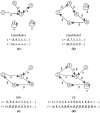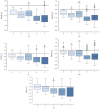Formal Definitions of Unbounded Evolution and Innovation Reveal Universal Mechanisms for Open-Ended Evolution in Dynamical Systems
- PMID: 28428620
- PMCID: PMC5430523
- DOI: 10.1038/s41598-017-00810-8
Formal Definitions of Unbounded Evolution and Innovation Reveal Universal Mechanisms for Open-Ended Evolution in Dynamical Systems
Abstract
Open-ended evolution (OEE) is relevant to a variety of biological, artificial and technological systems, but has been challenging to reproduce in silico. Most theoretical efforts focus on key aspects of open-ended evolution as it appears in biology. We recast the problem as a more general one in dynamical systems theory, providing simple criteria for open-ended evolution based on two hallmark features: unbounded evolution and innovation. We define unbounded evolution as patterns that are non-repeating within the expected Poincare recurrence time of an isolated system, and innovation as trajectories not observed in isolated systems. As a case study, we implement novel variants of cellular automata (CA) where the update rules are allowed to vary with time in three alternative ways. Each is capable of generating conditions for open-ended evolution, but vary in their ability to do so. We find that state-dependent dynamics, regarded as a hallmark of life, statistically out-performs other candidate mechanisms, and is the only mechanism to produce open-ended evolution in a scalable manner, essential to the notion of ongoing evolution. This analysis suggests a new framework for unifying mechanisms for generating OEE with features distinctive to life and its artifacts, with broad applicability to biological and artificial systems.
Conflict of interest statement
The authors declare that they have no competing interests.
Figures









Similar articles
-
A Procedure for Testing for Tokyo Type 1 Open-Ended Evolution.Artif Life. 2024 Aug 1;30(3):345-355. doi: 10.1162/artl_a_00430. Artif Life. 2024. PMID: 38635908
-
Zipf's Law, unbounded complexity and open-ended evolution.J R Soc Interface. 2018 Dec 21;15(149):20180395. doi: 10.1098/rsif.2018.0395. J R Soc Interface. 2018. PMID: 30958235 Free PMC article.
-
Undecidability and Irreducibility Conditions for Open-Ended Evolution and Emergence.Artif Life. 2018 Winter;24(1):56-70. doi: 10.1162/ARTL_a_00254. Epub 2018 Jan 25. Artif Life. 2018. PMID: 29369710
-
Grand Views of Evolution.Trends Ecol Evol. 2017 May;32(5):324-334. doi: 10.1016/j.tree.2017.01.008. Epub 2017 Feb 27. Trends Ecol Evol. 2017. PMID: 28245930 Review.
-
Towards open-ended evolution in self-replicating molecular systems.Beilstein J Org Chem. 2017 Jun 21;13:1189-1203. doi: 10.3762/bjoc.13.118. eCollection 2017. Beilstein J Org Chem. 2017. PMID: 28694865 Free PMC article. Review.
Cited by
-
On the salient limitations of the methods of assembly theory and their classification of molecular biosignatures.NPJ Syst Biol Appl. 2024 Aug 7;10(1):82. doi: 10.1038/s41540-024-00403-y. NPJ Syst Biol Appl. 2024. PMID: 39112510 Free PMC article. Review.
-
Predicting phenotype transition probabilities via conditional algorithmic probability approximations.J R Soc Interface. 2022 Dec;19(197):20220694. doi: 10.1098/rsif.2022.0694. Epub 2022 Dec 14. J R Soc Interface. 2022. PMID: 36514888 Free PMC article.
-
Self-replication of a quantum artificial organism driven by single-photon pulses.Sci Rep. 2021 Aug 12;11(1):16433. doi: 10.1038/s41598-021-96048-6. Sci Rep. 2021. PMID: 34385582 Free PMC article.
-
Emergence and algorithmic information dynamics of systems and observers.Philos Trans A Math Phys Eng Sci. 2022 Jul 11;380(2227):20200429. doi: 10.1098/rsta.2020.0429. Epub 2022 May 23. Philos Trans A Math Phys Eng Sci. 2022. PMID: 35599568 Free PMC article.
-
Exploring Simplicity Bias in 1D Dynamical Systems.Entropy (Basel). 2024 May 16;26(5):426. doi: 10.3390/e26050426. Entropy (Basel). 2024. PMID: 38785675 Free PMC article.
References
-
- Bedau, M. A., Snyder, E. & Packard, N. H. A classification of long-term evolutionary dynamics. In Artificial life VI, 228–237, Cambridge: MIT Press (1998).
-
- Skusa A, Bedau MA. Towards a comparison of evolutionary creativity in biological and cultural evolution. Artificial Life. 2003;8:233–242.
Publication types
LinkOut - more resources
Full Text Sources
Other Literature Sources
Research Materials

